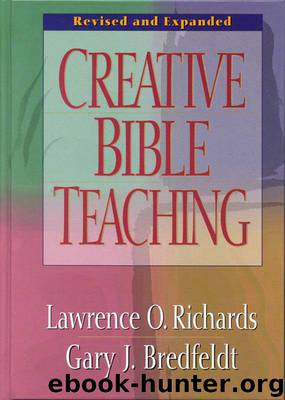Creative Bible Teaching by Lawrence O. Richards & Gary J. Bredfeldt

Author:Lawrence O. Richards & Gary J. Bredfeldt [Richards, Lawrence O.]
Language: eng
Format: mobi
ISBN: 9780802416445
Publisher: Moody Publishers
Published: 1998-03-01T05:00:00+00:00
Categories of Methods
Cognitive methods. One way we could categorize the methods available to creative Bible teachers is by learning domains. Let’s consider the cognitive domain. What methods are most effective in stimulating thinking? Well, that depends on what level of learning transfer we are hoping to achieve (see figure 10 in chapter 7). At the rote memory level, methods that emphasize memory recall are desirable. Songs, puzzles, simple games, acrostics, and other memory aids are useful. But the teacher must understand that these methods only enable the student to recall information. To recall a verse from memory by use of a Scripture song is not the same as understanding the meaning of the Scripture. At higher levels of learning, such as at the recognition, restatement, relation, and realization levels, methodology must become more student centered. The role of the teacher shifts from telling to guiding and, therefore, the method must shift from teacher centered to student centered.
Cognitive methods can include brainstorming, small group discussion, case study analysis, debates, forums, interviews, neighbor nudging (a brief discussion in groups of two), panel discussions, question and answer, provocative questions, open-ended stories (stories the group gets to complete), parables, skits, role plays, and lecture. Notice that different methods demand different levels of student involvement. Generally, the greater the involvement, the higher the level of learning that is achieved. Involvement is not necessarily in the form of activity, however. Students can become involved in a well-delivered lecture that stimulates higher levels of thinking. Some methods basically provide information. Others force students to think through the information or solve a problem with the information (e.g., case study). These are only a few of the options teachers have available. In a moment, we will examine a set of criteria for identifying which method is best suited to your class.
Affective methods. A second category of methods includes those that are most readily suited to the affective domain of learning. Remember, the affective domain deals with human emotions, values, attitudes, convictions, and motivations. Methods that help a teacher tap into this area of student learning tend to require the use of story. For example, Jesus used parables to deal with the matter of His learners’ value system. His parabolic stories taught thought-provoking lessons. In many cases, the lesson required His listeners to do some personal soul-searching to fully understand the story. Take the parable of the famous “Good Samaritan.” This parable of robbery and religious piousness is designed to evoke a reaction among Jesus’ listeners. It was the hated Samaritan who helped the man in need; the self-absorbed religious leaders had not responded. Jesus told the parable to make some uncomfortable enough to evaluate their values and the genuineness of their faith. What was Jesus’ learning target? The affective domain.
Probably the most potent methods for teaching in the affective domain are those that involve modeling the truth. It has been said that “more is caught than taught.” Jesus used modeling to teach servanthood by washing His disciples’ feet. His
Download
This site does not store any files on its server. We only index and link to content provided by other sites. Please contact the content providers to delete copyright contents if any and email us, we'll remove relevant links or contents immediately.
Joan of Arc by Mary Gordon(3987)
Victory over the Darkness by Neil T. Anderson(2784)
The Gnostic Gospels by Pagels Elaine(2445)
Devil, The by Almond Philip C(2249)
The Nativity by Geza Vermes(2153)
The Psychedelic Gospels: The Secret History of Hallucinogens in Christianity by Jerry B. Brown(2097)
Going Clear: Scientology, Hollywood, and the Prison of Belief by Lawrence Wright(1912)
Going Clear by Lawrence Wright(1897)
A TIME TO KEEP SILENCE by Patrick Leigh Fermor(1813)
Barking to the Choir by Gregory Boyle(1749)
Old Testament History by John H. Sailhamer(1734)
Augustine: Conversions to Confessions by Robin Lane Fox(1716)
A History of the Franks by Gregory of Tours(1655)
A Prophet with Honor by William C. Martin(1646)
The Bible Doesn't Say That by Dr. Joel M. Hoffman(1623)
The Knights Templar by Sean Martin(1610)
by Christianity & Islam(1580)
The Amish by Steven M. Nolt(1509)
The Source by James A. Michener(1506)
